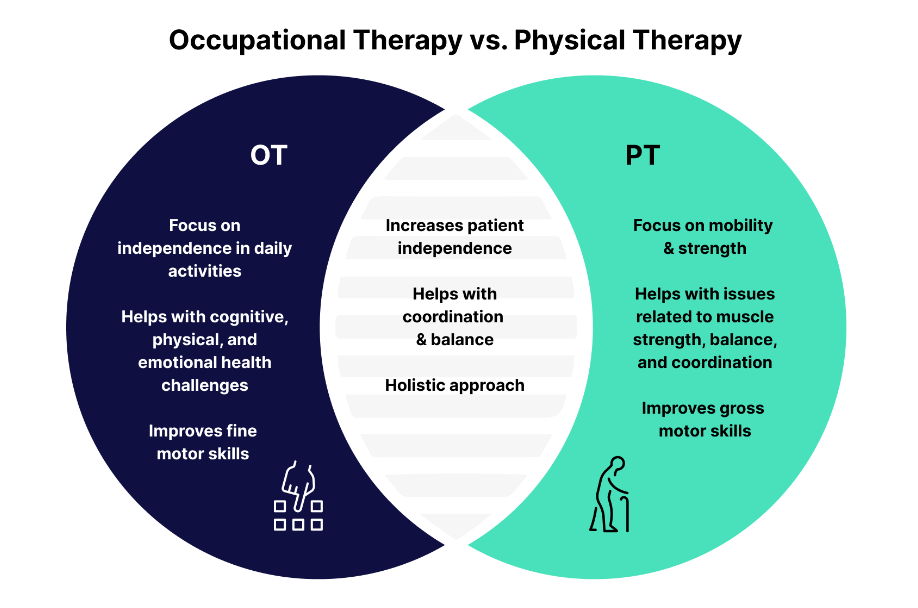Physical Therapy vs. Occupational Therapy: What's the Difference and Which Do You Need?
Confused between physical therapy and occupational therapy? You’re not alone — here’s what truly sets them apart and how each can help you.
Key Takeaways:
- Physical therapy (PT) focuses on improving physical function, mobility, strength, and pain relief.
- Occupational therapy (OT) helps patients regain independence in daily tasks like dressing, bathing, and eating.
- Both therapies often work together to create a full, personalized recovery plan.
- Choosing between PT and OT depends on your goals—mobility vs. daily task performance.
What’s the Difference Between Physical Therapy and Occupational Therapy?
Question: What is the difference between physical therapy and occupational therapy?
Answer: Physical therapy aims to restore movement and function in the body, while occupational therapy helps patients perform daily activities with greater ease and independence.
Physical Therapy: Focused on Movement and Pain Relief
Physical therapists help patients improve physical function through exercises, manual techniques, and mobility training. PT is especially beneficial after injury, surgery, or neurological conditions like stroke or Parkinson’s Disease.
Common goals of physical therapy:
- Reduce pain and inflammation
- Improve range of motion and strength
- Prevent falls and re-injury
- Restore walking, balance, and physical function
Conditions often treated by PT:
- Joint pain (knee, shoulder, hip)
- Stroke and neurological recovery
- Sports injuries
- Arthritis and chronic pain
- Post-operative rehabilitation
Occupational Therapy: Helping You Return to Daily Life
Occupational therapists help patients overcome barriers in performing essential daily tasks. OT goes beyond physical movement—it incorporates cognitive and sensory support to help individuals live independently and safely.
Common goals of occupational therapy:
- Improve hand coordination and fine motor skills
- Enhance self-care (e.g., dressing, hygiene, eating)
- Support cognitive challenges (e.g., memory, focus)
- Recommend adaptive tools and home modifications
Conditions often treated by OT:
- Parkinson’s Disease
- Stroke or brain injury
- Developmental delays
- Arthritis in the hands
- Recovery from hand surgery
When Do You Need Both PT and OT?
Many rehabilitation plans, especially for seniors and patients with neurological conditions, include both PT and OT. For example:
- After a stroke: PT helps restore walking ability, while OT helps you re-learn how to cook or write.
- For Parkinson’s Disease: PT addresses gait and balance, while OT focuses on dressing and hand function.
At Synaptic Rehabilitation, our therapists work together to ensure comprehensive recovery by integrating both physical and occupational therapy when needed.
How We Help at Synaptic Rehabilitation
If you’re located in Bridgewater, NJ or surrounding areas, Synaptic Rehabilitation offers both in-home and clinic-based physical and occupational therapy services. Whether you’re recovering from surgery, managing a chronic condition, or supporting a loved one with neurological challenges, we’re here to help.
Get Expert & Professional Help Today!
In-home physical therapy and occupational therapy provide a valuable service for patients dealing with a variety of conditions, offering both convenience and customized care. Whether you’re managing arthritis, recovering from surgery, or working to improve balance or hand coordination, our therapists are here for you.
Visit our Bridgewater clinic or schedule a consultation today to explore which therapy is right for you.
Steven Cheung, DPT
Steven is the founder and lead physical therapist at SYNAPTIC Rehabilitation. He earned a BS in Exercise Science Applied Kinesiology from Rutgers University in New Brunswick, NJ and his Doctorate degree from American International College in Springfield, MA. Steven specializes in movement disorders such as Parkinson’s disease and many other neurological disorders. Outside of practicing physical therapy Steven enjoys time with his wife, running, and staying active.

